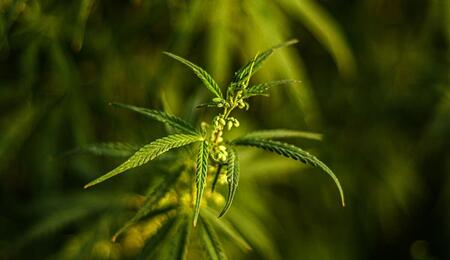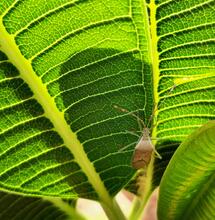Organic Nutrients and Chemical Shortcuts

One hotly contested topic of cannabis gardeners is whether to use chemical based, or organic nutrients. While it is fine to disagree, there are benefits to both sides, and ignoring the camp you don't agree with has been the cause of a lot of ignorance in the world.
Nitrogen (N), phosphorus (P), potassium (K), and other nutrients are needed by plants for healthy growth. These are elements, and as such, there is no difference between the nitrogen (N) from an organic nutrient, or a chemical nutrient. Elemental nitrogen is the exact same thing regardless of the source.
What garden plants most often use to allow them to take up nitrogen (N) is a form known as nitrate (NO3), which is a nitrogen (N) atom connected with three oxygen (O) atoms. Nitrate (NO3) is easy for the plants to separate the nitrogen (N) from the oxygen (O), and therefore makes for a good source of nitrogen (N) (woody plants like trees can also use ammonium (NH4)).
Plant material that has fallen to the ground and animals leaving waste material are two sources of nitrogen (N) that are naturally occurring in untended wilderness. To emulate this, organic nutrients tend to be made from naturally occurring materials with minimal processing. One advantage to this is that the materials can often be collected cheaply (i.e. leaves, lawn clippings, livestock manure etc.) Compost (3-1-2) is very similar to what happens in nature when leaves fall, and assorted other plant material winds up on the ground when nobody is around to rake it up. It is as these things decompose (or compost) that bacteria and fungi convert them into ammonia (NH3), and ammonium (NH4). This process takes time as the bacteria process the ammonia as they get to it.
I like to compare organic nutrients to eating oatmeal for breakfast, they tend to be bulky and release their nutrients over a long period of time. Some forms of organic fertilizers can continue to release nutrients for more than one season, improving the general long term health of the soil. Because the percentage of nutrient to total mass tends to be lower, the NPK values for organic nutrients tend to be lower than for chemical based solutions. Because they are closer to a natural state, the NPK values for organic products also tend to be less exact than with chemical based fertilizers, which can be made to exact recipes. With the exception of high ammonia “hot” manures, organic nutrients tend to be less prone to overfeeding. Compost, worm casting, and fish excrement can be used in almost unlimited quantities without causing “nute burn”. Since organic nutrients tend to be less processed, they also tend to be more prone to clogging hydroponic systems that rely on sprayers and pumps.
However, there is more than one way to make ammonia (NH3) it can also be a manufactured chemical made from nitrogen gas (N2) by applying heat, pressure, and an iron catalyst. Ammonium sulfate ((NH4)2SO4 ) and ammonium nitrate (NH4)(NO3) are other manufactured forms of nitrogen that allow for later parts of the process so be skipped over. Any of these allow for a short cut in the process, and makes the nitrogen available faster than with the natural process.
Chemical nutrients are more like having an energy drink for breakfast, they release their nutrients quickly, and then need more to avoid a “crash”. Since chemical nutrients are shortcuts to the natural process, they can allow for a greater level of control as to how much and when the nitrogen becomes available to the plants. This can allow for a higher nutrient level and resulting increase in performance than is possible with organic nutrients.
With this level of control comes responsibility however, as introducing an overabundance becomes a much more likely temptation, which can result in “nute burn” or overloading and damaging natural systems with the runoff. Adding a chemical nitrate (NO3) for example, allows for the entire nitrate (NO3) creation process to be skipped, and immediately supply nitrogen (N) to the plants, but it is also very water soluble, and what isn’t taken up by the plant will quickly wash downstream (unless recirculated) .
Overdosing plants with chemicals can imbalance a natural system to the point that becomes inhospitable to the beneficial bacteria and fungi normally responsible for the process. Because chemical fertilizers are shortcuts to the process, using them to treat nutrient deficiencies will tend to give faster results than an organic solution which is better suited for long term release. Depending on the exact chemical used, there may also be “leftover” residue after the ammonia or nitrate is used which can build up in the system over time. This is where the practice of watering heavily without nutrients for a time (flushing) comes from, to help wash away any leftover chemical residue buildup.
Regardless of the source, if the ammonia (NH3) is exposed to acidic conditions (pH less than 7) it picks up another hydrogen (H) atom and converts to ammonium (NH4). This is part of why pH can have an effect on plant growth, if the pH is too high, this conversion is inhibited. Beneficial bacteria then convert the ammonium (NH4) to nitrate (NO3) which can then be used by the garden plants.
Phosphorus can be obtained naturally from organic composts, rock phosphate or bone meal, or it can come from chemicals such as ammoniated super phosphate (5-50-0), or ammonium phosphate (18-46-0). Overuse of phosphorus is one of the sources of environmental pollution. Potassium can be from organic sources like compost (3-1-2), kelp (1-0-4), or from a chemical such as (13-0-44).
The differences between chemical and organic nutrition are not as absolute as they are often portrayed, they both supply the same elements to the plants. The primary differences are in how many shortcuts are taken, and what remains afterwards. Although purists on both sides may strongly disagree, I believe there is little reason not to make use of the benefits of both in moderation. Plants awaiting organic nutrients to become available may benefit from a little chemical boost to tide them over, and long lasting organic materials can help create a buffer for fast acting chemical nutrient gardens.
Sometimes a big hearty high fiber breakfast is what is what a person needs to start the day, and sometimes you just need a good strong cup of coffee to get your eyes to open. As always, understanding why you are adding something to your garden, and how it works, goes a long way toward picking what's right for you.
Peace, love and puka shells,
Grubbycup
More from Soft Secrets:



.png)







